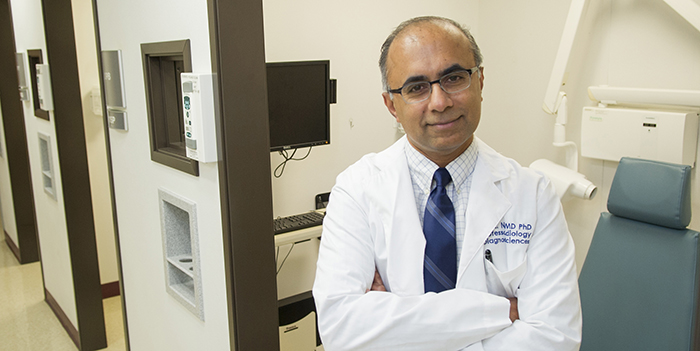Progress notes

Dr. Madhu “Matt” Nair brings a unique perspective to the Department of Diagnostic Sciences at Texas A&M College of Dentistry as professor of radiology and director of the Imaging Center. Nearly 20 years ago, a desire to further his skill set in oral and maxillofacial radiology led him to pursue a second master’s in the specialty, and soon after, a doctorate. Only a handful of schools worldwide offer a PhD in radiology, which led Nair to the University of Gothenburg in Sweden, where he researched translational 3D imaging technology with radiology greats like Dr. Hans-Göran Gröndahl and Dr. Richard Webber. It’s the very institution where Dr. Per-Ingvar Bränemark introduced titanium implants to clinical dentistry.
Nair also underwent fellowship training in medical radiology informatics at the University of Pittsburgh Medical Center, all the while serving as a faculty member and director of the school’s radiology division. He followed this as vice chair of the University of Florida College of Dentistry’s oral and maxillofacial surgery and diagnostic sciences department and, later, founding chairman of what became oral and maxillofacial diagnostic sciences. It’s the country’s largest maxillofacial radiology program, with 12 residents and several fellows.
Expanded purview came through his role as program director of the radiology residency program and division chief of maxillofacial radiology at the university’s medical school and Shands Hospital system.
Now, nearly seven months into his post here in Dallas, it’s these past experiences that offer the perfect opportunity for us to pick his brain on what makes for a great imaging center, his thoughts on the future of the field, and what it will take to get there.
You obviously stay up to date on the latest in the specialty as a director on the American Board of Oral and Maxillofacial Radiology. What’s on the horizon for this field?
As I tell my residents and students, the sky is indeed the limit. Collaborative efforts with medical radiology are central to the growth and development of the specialty. More interaction with other specialties including medical radiology, otolaryngology and dental specialties, and also with patients on a daily basis as part of the caregiver team will greatly enhance the visibility and relevance of the specialty. As for oral and maxillofacial radiology, teleradiology is also growing by leaps and bounds, and we have a fairly large clientele in our imaging center, comprising dentists and dental specialists, who use our services to interpret advanced imaging studies acquired in their practices.
What role does technology play in this progression?
One has to be proactive in harnessing the technology that is so widely used in medical radiology in order for the specialty to advance. Interventional radiology is an area of great interest to me as is artificial intelligence and deep learning as tools that can be developed to optimize the workflow and efficiencies of practice and improve quality of service through decision-support algorithms. Establishing the infrastructure for such development is the first step. Dentistry is lagging behind in the area of PACS — picture archiving communication systems — cloud computing and big data. The future is bright, but murky as well, as we try to find a way to harness artificial intelligence and deep learning to enhance the quality of our service and our own professional lives as health care providers.
You have trained and worked at multiple dental schools in the U.S. and abroad. What is the significance of a dental school having this kind of an imaging center facility? Also, how does ours compare?
An imaging center is an asset to an educational institution. I am truly impressed at what the College of Dentistry has achieved to date through the establishment of its center, which caters to the needs of the school patients and those from outside offices while contributing to the educational and research missions of the school. Students have firsthand experience during their rotations to see and appreciate what radiologists do to enhance the quality of care of their patients while learning and observing cutting-edge technology at work. It is a unique experience not usually seen in other dental schools.
Furthermore, by providing centralized advanced imaging services to patients, the Imaging Center ensures quality assurance, meaningful use of resources to provide state-of-the-art technology to our patients without costs spiraling out of control, as is seen with decentralized imaging operations that duplicate the same effort in multiple areas.